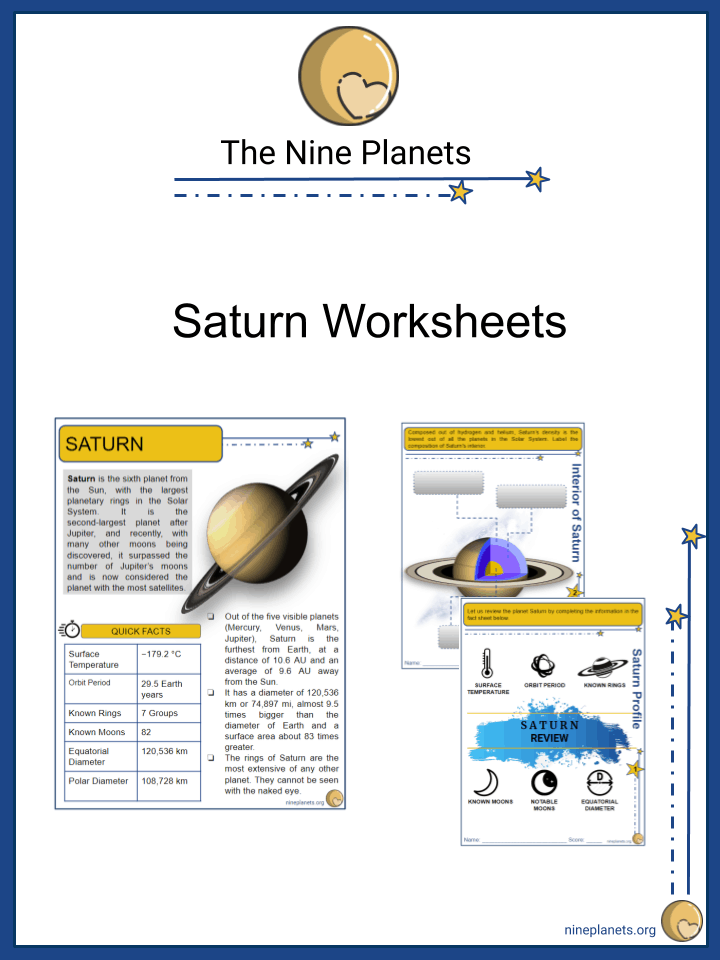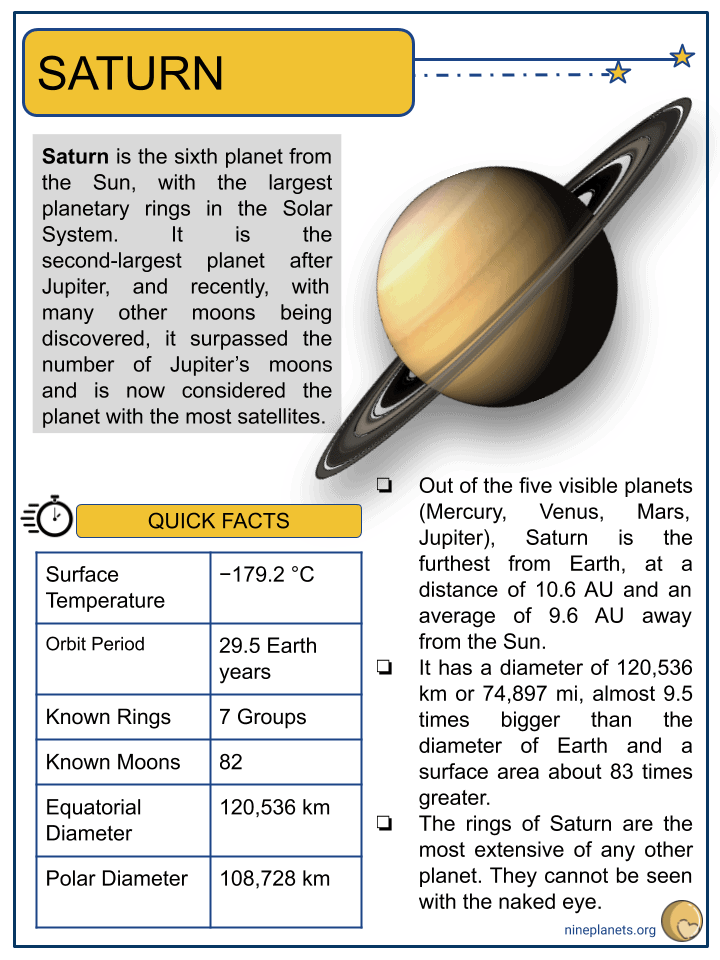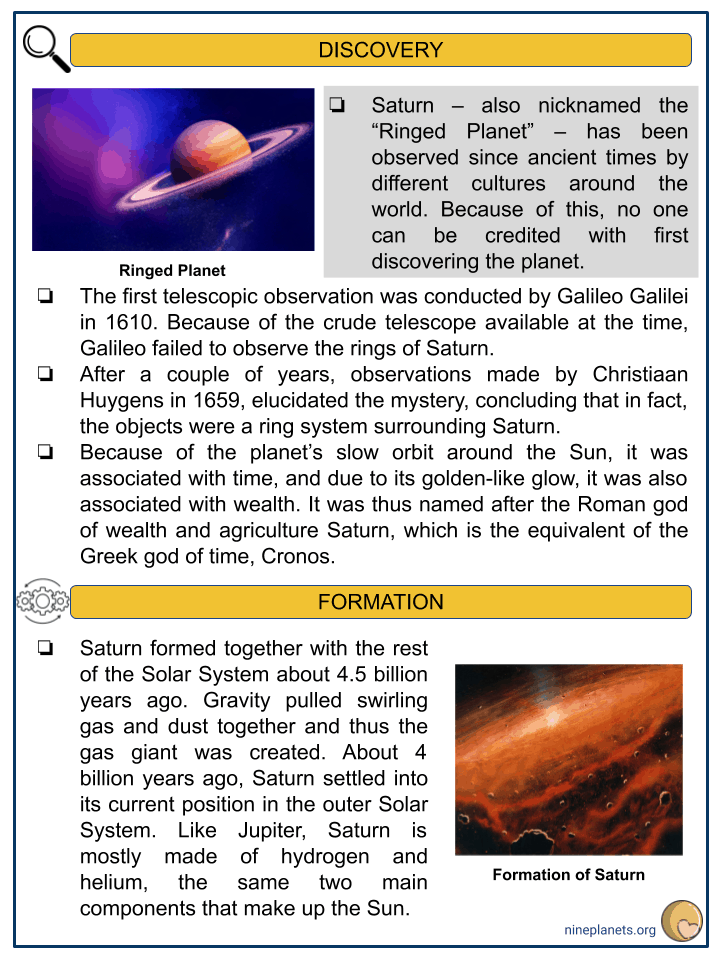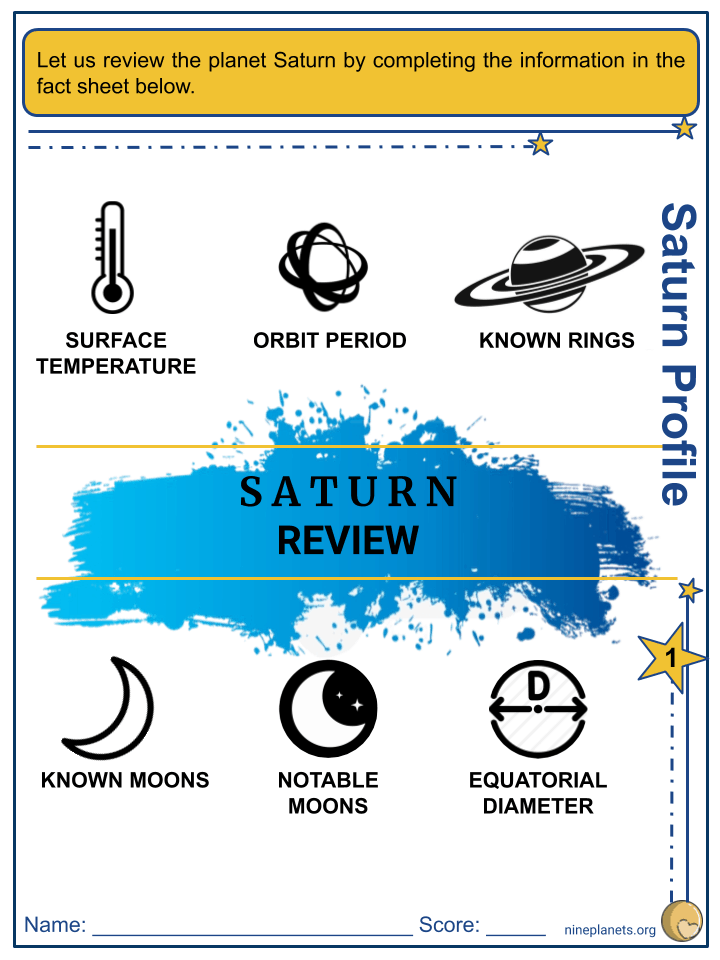Download Saturn Worksheets
Click the button below to get instant access to these premium worksheets for use in the classroom or at a home.

This worksheet can be edited by Premium members using the free Google Slides online software. Click the Edit button above to get started.
Download free sample
Not ready to purchase a subscription yet? Click here to download a FREE sample of this worksheet pack.
Resource Examples
Click any of the example images below to view a larger version.




Key Facts & Information
- Saturn is the sixth planet from the Sun, with the largest planetary rings in the Solar System. It is the second-largest planet after Jupiter, and recently, with many other moons being discovered, it surpassed the number of Jupiter’s moons and is now considered the planet with the most satellites.
Quick Facts
- Surface Temperature: −179.2 °C
- Orbit Period: 29.5 Earth years
- Known Rings: 7 Groups
- Known Moons: 82
- Equatorial Diameter: 120,536 km
- Polar Diameter: 108,728 km
- Out of the five visible planets (Mercury, Venus, Mars, Jupiter), Saturn is the furthest from Earth, at a distance of 10.6 AU and an average of 9.6 AU away from the Sun.
- It has a diameter of 120,536 km or 74,897 mi, almost 9.5 times bigger than the diameter of Earth and a surface area about 83 times greater.
- The rings of Saturn are the most extensive of any other planet. They cannot be seen with the naked eye.
Discovery
- Saturn – also nicknamed the “Ringed Planet” – has been observed since ancient times by different cultures around the world. Because of this, no one can be credited with first discovering the planet.
- The first telescopic observation was conducted by Galileo Galilei in 1610. Because of the crude telescope available at the time, Galileo failed to observe the rings of Saturn.
- After a couple of years, observations made by Christiaan Huygens in 1659, elucidated the mystery, concluding that in fact, the objects were a ring system surrounding Saturn.
- Because of the planet’s slow orbit around the Sun, it was associated with time, and due to its golden-like glow, it was also associated with wealth. It was thus named after the Roman god of wealth and agriculture Saturn, which is the equivalent of the Greek god of time, Cronos.
Formation
- Saturn formed together with the rest of the Solar System about 4.5 billion years ago. Gravity pulled swirling gas and dust together and thus the gas giant was created. About 4 billion years ago, Saturn settled into its current position in the outer Solar System. Like Jupiter, Saturn is mostly made of hydrogen and helium, the same two main components that make up the Sun.
Distance, Size & Mass
- Saturn is about 9.5 times further away from the Sun than the Earth. At a distance of 9.6 AU from the Sun and 10.6 AU from Earth, it is the sixth most distant planet.
- Light takes approximately 1 hour and 29 minutes to travel from Saturn and then arrive on Earth.
- It is the second-largest planet in the Solar System, having a diameter of 120,536 km and a radius of 58,232 km, about nine times that of Earth.
- Though the volume of Saturn is about 764 times that of Earth, it is the least dense planet in the Solar System. The density of Saturn has been estimated to be about 0.687 g/cm3, less dense than water due to its gaseous composition.
Orbit And Rotation
- Saturn has the second-shortest day in the Solar System, completing a rotation quite quickly, in about 10.6 hours. However, its orbit around the Sun is slow, completing one trip around the Sun a year, in about 29.5 Earth years. Its average orbital speed is about 9.68 km/s – 6.01 mi/s.
- The elliptical orbit of Saturn is inclined 2.48° relative to the orbital plane of the Earth.
- Due to Saturn’s axial tilt of 26.73 degrees, similar to that of Earth, the southern and northern hemispheres are heated differently, causing seasonal temperature variations.
Structure
- Predominantly composed out of hydrogen and helium, Saturn’s density is the lowest out of all the planets in the Solar System.
- It does have a dense core in the centre, composed out of water, ice, and rocky materials, but no actual landmass.
- The core is believed to be similar to that of Jupiter – rocky, enveloped by a liquid metallic hydrogen layer and a molecular hydrogen layer with traces of various ices.
- The thick liquid metallic hydrogen layer followed by a liquid layer of helium-saturated molecular hydrogen gradually transitions to a gas with increasing altitude. The outermost layer spans 1,000 km / 621 mi and consists of gas.
- Atmosphere. Covered with clouds that appear as faint stripes, jet streams and storms, Saturn’s upper atmosphere is characterised by winds that can reach up to 1,600 feet/500 metres per second.
- The atmosphere is composed of ammonia, ammonia hydrosulfide, and water that influence the planet’s colourful appearance of a brownish-yellow.
- The Great White Spot of Saturn is comprised of many periodic storms large enough to be seen from Earth through a telescope. They are several kilometres wide and encircle the planet, occurring once roughly every Saturnian year – every 30 Earth years.
Moons
- Saturn is now the “king of the moons” in the Solar System, having a total of 82 confirmed and diverse satellites that range from a couple of metres to several hundred kilometres.
- Out of the 82 moons, only 24 are regular satellites, which means they have prograde orbits not greatly inclined to Saturn’s equatorial plane; and 58 irregular moons that orbit much further from Saturn, high inclinations, and are mixed between prograde and retrograde motions.
- Saturn has seven major satellites or notable moons, with one of them being even bigger than the planet Mercury: Titan, Lapetus, Rhea, Dione, Tethys, Enceladus and Mimas
- Titan is the first discovered moon of Saturn. It was discovered in 1655 by astronomer Christiaan Huygens. It is the largest moon of Saturn and the second-biggest moon in the Solar System.
- Lapetus is the third-largest moon of Saturn and has the largest orbital inclination, 15.47°.
- Rhea was discovered in 1672 by G.D. Cassini. It is named after the “mother of the gods” in Greek mythology and the second-largest moon of Saturn.
- Dione is the second-largest inner moon of Saturn. About two-thirds of Dione’s mass is water ice.
- Tethys is the third-largest inner moon of Saturn. It has the lowest density out of all the moons suggesting it is primarily made out of water, and a small fraction of rock.
- Enceladus is the sixth-largest moon of Saturn. It was discovered in 1789 by William Herschel. This moon is mostly covered by fresh, clean ice, making it one of the most reflective bodies of the Solar System.
- Mimas is named after Mimas, a son of Gaia in Greek mythology. It has a diameter of 396 kilometres and the smallest astronomical body.
Planetary Rings
- The moons of Saturn also play a role in the planet’s ring system.
- The ring system of Saturn is the largest and most complex in the entire Solar System. They are made out of ice and rock remnants from comets, asteroids and moons.
- These particles range in size from being as small as dust to as big as houses, or even mountains. The ring system is divided into 7 groups of rings: D Ring, C Ring, B Ring, A Ring, F Ring, G Ring and E Ring.
Did You Know?
- It is estimated that Saturn will lose its rings in about 100 million years. The rings are being pulled into Saturn by gravity as a dusty rain of ice particles under the influence of Saturn’s magnetic field. This event is often called Ring Rain.
- The closest distance of Saturn to Earth will happen in 2091, at a distance of 8.03 AU.
- You could fit 764 Earths inside Saturn, and almost 1,600 Saturns could fit into the Sun.
- Controversially, recent studies of ancient cultures show that they might have mistakenly considered Saturn as the Sun or at least, a Sun-like object. Some cultures considered that Saturn was a star.
- The winds on Saturn are the second fastest among the Solar System’s planets, after Neptune’s.
- Twice every Saturnian year – roughly every 15 Earth years – the rings of Saturn briefly disappear from view, due to the way in which they are angled and because they are thin. Such an event will next occur in 2025, but Saturn will be too close to the Sun for any ring-crossing observation to be possible.
- Saturn’s largest moon Titan comprises more than 96% of the mass in orbit around the planet.
- Scientists surmise that the atmosphere of early Earth was similar in composition to the current atmosphere on Titan, with the important exception of a lack of water vapour on Titan.
- Only four spacecrafts have visited Saturn: NASA’s Pioneer 11 in 1979, NASA’s twin Voyager 1 & 2 in 1980 and 1981, and the international Cassini spacecraft mission in 2004.